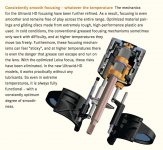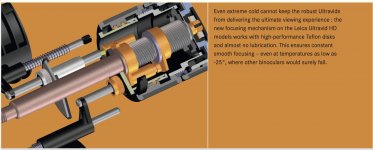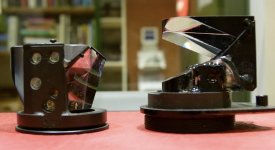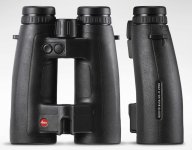-
Welcome to BirdForum, the internet's largest birding community with thousands of members from all over the world. The forums are dedicated to wild birds, birding, binoculars and equipment and all that goes with it.
Please register for an account to take part in the discussions in the forum, post your pictures in the gallery and more.
You are using an out of date browser. It may not display this or other websites correctly.
You should upgrade or use an alternative browser.
You should upgrade or use an alternative browser.
Wish List... (1 Viewer)
- Thread starter ticl2184
- Start date
More options
Who Replied?The radical reinvention I'd like to see is a stabilized dual power binocular, offering a very wide angle low (2x-4x) power setting along with a stabilized 10x.Most of these wishes are tweaks to what we already have…I want radical reinvention.
Birds move a lot and it is problematical for instance to follow warblers in tree tops at 10x.
A wide angle low power view for tracking combined with a high power view for detail observation would be very helpful.
John A Roberts
Well-known member

Titanium In Leica Ultravids
To quote from a 2003 catalogue on the introduction of the Ultravid BR/ BL line:
'Magnesium and titanium are the strengths of the Ultravid lightweights. A body shell made completely of magnesium and the hinge shaft of highly rigid titanium guarantee longevity and they are what make the lightness of the Ultravid models possible.'
So as Fazal indicates in post #36, it is the hinge shaft - rather than the focuser housing - that’s made from titanium.
And the catalogue also includes a sequence of three photos showing: the rough castings of the main body housings; the semi-finished housings with the hinge shaft and objective housings fitted, and; the finished assembly.
In relation to the focuser, when the Ultravid HD was introduced in 2007, considerable stress was placed on the improvements to the focus mechanism.
See two images from a 2007 catalogue (the second shows the mechanism in clearer detail), and note the careful qualifications of 'practically without any lubricants' and 'almost no lubrication'.
Both catalogues can be found at: Company Seven | Leica Notes and Interesting Articles
John
To quote from a 2003 catalogue on the introduction of the Ultravid BR/ BL line:
'Magnesium and titanium are the strengths of the Ultravid lightweights. A body shell made completely of magnesium and the hinge shaft of highly rigid titanium guarantee longevity and they are what make the lightness of the Ultravid models possible.'
So as Fazal indicates in post #36, it is the hinge shaft - rather than the focuser housing - that’s made from titanium.
And the catalogue also includes a sequence of three photos showing: the rough castings of the main body housings; the semi-finished housings with the hinge shaft and objective housings fitted, and; the finished assembly.
In relation to the focuser, when the Ultravid HD was introduced in 2007, considerable stress was placed on the improvements to the focus mechanism.
See two images from a 2007 catalogue (the second shows the mechanism in clearer detail), and note the careful qualifications of 'practically without any lubricants' and 'almost no lubrication'.
Both catalogues can be found at: Company Seven | Leica Notes and Interesting Articles
John
Attachments
Last edited:
CharleyBird
Well-known member

Binoculars that can make the wearer invisible, soundless, and scentless, all at the push of a button.Most of these wishes are tweaks to what we already have…I want radical reinvention.
The topic of carbon fibre has been covered before. The lay-up for a binocular housing would be complex and expensive for a minor weight saving, when you consider all that glass. Thermal conductivity doesn't play any role for binoculars with low magnification and most nowadays have insulating rubber armouring anyway.
As regards titanium, its wall thickness would have to be a third of a magnesium housing or half that of an aluminium housing to save any weight and would probably be vulnerable to buckling (coke can effect). AFAIK, you couldn't cast it anyway and its machinability is problematic.
John
Gee... it's almost as though the folks for whom manufacturing binoculars is their business actually do know a thing or two about manufacturing binoculars!
I suppose a carbon fibre composite housing could be made, substituting carbon fibre for the polyamide (nylon) used in FLs. But what would the actual weight loss actually be? I suspect if any real weight savings are going to be made they are likely to be in lenses - plastic lenses with similar performance to current glass lenses but at a lighter weight, or metalenses.
For me a stabillized 10x50 NL, that handles like a large x42, would be amazing. But given the already hefty price of the NL and the extra premium that the consumer would no doubt have to pay for Swaro-stabilization, I wouldn't be able to afford it.
For the longer term something with photo or video attachments, no doubt stabillized, would be sensational. There's been many a sight I've seen through my binoculars I would dearly love to have been able to record and playback. Swarovski do have experience of modular concept instruments (ATX, BTX) - and maybe one day the tech will get to the point that a modular system will allow video to be incorporated into a binocular. I could see this system having a separate ocular unit, a stabillized body (maybe incorporating the objective end optics), and a specific video/recording module, maybe attaching between the eyepieces and body, that could be removed if you wanted to use binoculars in the classic manner. The video module is the bit that could be updated as the technology advances - so you don't have to buy a new Swarostabilized binocular. It's not impossible that as technology advances, it might be possible to package all these capabilities into something no bigger than a large modern x42 like the SF. But that day is probably some time off. In the meantime I'd gratefully take the stabillized 10x50 NL mentioned above!
james holdsworth
Consulting Biologist
Lol, doesn’t really help though…I can’t walk a km out into the lake, even if the birds can’t see me.Binoculars that can make the wearer invisible, soundless, and scentless, all at the push of a button.
ticl2184
Well-known member
Good point.I wonder why Leica did not do more with the Perger prisms (the modified porro prisms). As yet they are only used in rangefinder binoculars.
Gijs van Ginkel
They committed a lot of time and resources to developing that product. I would have imagined a non-rangefinder version would have also been launched.
I'm not really sure about what advantage the perger prism had over the standard prism design. I tested a pair a few weeks ago and there was nothing that special. Edge of field softness was significant. Brightness was average and it was hard to distinguish the display. Also they were quite bulky ..
Cheers
Tim
Total internal reflection (no aluminium, silver or dielectric mirror coatings), no need for phase coatings and less bulk than traditional Porro 1 or Porro2.I'm not really sure about what advantage the perger prism had over the standard prism design.
John
Last edited:
ticl2184
Well-known member
With those advantages why aren't they used more often....Total internal reflection (no aluminium, silver or dielectric mirror coatings), no need for phase coatings and less bulk than traditional Porro 1 or Porro2.
John
Are they more expensive to produce ?
Cheers
Tim
John A Roberts
Well-known member

Hi Tim,
For images and details about Andreas Perger’s prisms see the thread: Perger Prisms
It includes the US version of his patent which was filed in 2011, which has three versions of the prism system.
And as Canip indicated in post #10, it seems that Leica has an exclusive licence.
John
For images and details about Andreas Perger’s prisms see the thread: Perger Prisms
It includes the US version of his patent which was filed in 2011, which has three versions of the prism system.
And as Canip indicated in post #10, it seems that Leica has an exclusive licence.
John
_Prism_
Well-known member

To quote from a 2003 catalogue on the introduction of the Ultravid BR/ BL line:
'Magnesium and titanium are the strengths of the Ultravid lightweights. A body shell made completely of magnesium and the hinge shaft of highly rigid titanium guarantee longevity and they are what make the lightness of the Ultravid models possible.'
So as Fazal indicates in post #36, it is the hinge shaft - rather than the focuser housing - that’s made from titanium.
And the catalogue also includes a sequence of three photos showing: the rough castings of the main body housings; the semi-finished housings with the hinge shaft and objective housings fitted, and; the finished assembly.
Fazal (post 36) and John (post 43) - Thank you for the clarification re: use of titanium in Leica Ultravids.
For images and details about Andreas Perger’s prisms see the thread: Perger Prisms
John (post 50) - Thanks for the link on Perger Prisms - it made for some interesting reading. I'm curious about your opinion as to why Leica doesn't use them in their other product lines (e.g. Ultravid)? Are roof prisms more compact than Perger's?
Cheers,
Ali
Chosun Juan
Given to Fly

Well rather than be prescriptive and get into lengthy discussions with all you retired old codgers about materials technology that is 30 years out of date (surprised no one has mentioned beryllium graphene, or 3D printing yet .... unless Ferrari objects ! lol) I will just set the parameters .....
How the manufacturers get there is up to them.
Not too much to ask for is it .... ? 😉
Chosun 👧
How the manufacturers get there is up to them.
- Earth Friendly (that includes no invasion of Indigenous People's country's to steal their resources too !)
- variable 7-9x to 12-20x zoom with auto IS
- 45mm objective diameter
- 76°AFov sharp to the edge
- 20mm ER
- 599 grams weight
- Best on market CA control
- Best on market glare control /blackness
- Best on market sharpness and resolution
- Best on market contrast /microcontrast
- Best on market aberration control
- Best on market clour neutrality, fidelity and saturation
- 96%+ transmission
- Dual density armouring/ perforated leather covering.
- Large knurled metal fast CW focusing wheel
- Best on market waterproofing
- Best on market tolerances and smoothness
- Nikon Monarch HG form factor ergonomics
- Sub $2000 AUD price with lifetime unconditional warranty.
Not too much to ask for is it .... ? 😉
Chosun 👧

Perhaps because they are not that compact and Leica usually strives to be the smallest and lightest in class.I wonder why Leica did not do more with the Perger prisms (the modified porro prisms). As yet they are only used in rangefinder binoculars.
Oil lenses as in Frank Herbert’s Dune:Most of these wishes are tweaks to what we already have…I want radical reinvention.
“OIL LENS: hufuf oil held in static tension by an enclosing force field within a viewing tube as part of a magnifying or other light-manipulation system. Because each lens element can be adjusted individually one micron at a time, the oil lens is considered the ultimate in accuracy for manipulating visible light.”
Well, I shoulda/coulda just said that...Well rather than be prescriptive and get into lengthy discussions with all you retired old codgers about materials technology that is 30 years out of date (surprised no one has mentioned beryllium graphene, or 3D printing yet .... unless Ferrari objects ! lol) I will just set the parameters .....
Last edited:
jan van daalen
Well-known member
Hi W220,An image stabilized NL 7x30 with weight no more than 650 grams/23 ounces.
Why would you want a stabilized 7x?
Jan
John A Roberts
Well-known member

Hi Ali (post # 51),
To help put things into context . . .
A) For some history and images (including the transmission paths) of the various roof and non-roof prisms used in handheld binoculars, see from post #28 on at: New Horizons II
B) In relation to roof vs Porros prisms in general:
* However, Schmidt-Pechans have a unique technical imitation compared to other roof prisms: the two facing surfaces perform both transmission and reflection functions. Consequently, the surfaces must be separate to enable reflection, but then any anti-reflective coating applied to aid transmission compromises the reflection quality.
C) Over time, the two roof prism winners have been the Schmidt-Pechan’s - by a big margin, and the longer Abbe-Koenig’s where better performance is required.
The chief S-P advantage is physical compactness, both front-to-back and side-to-side. See an image comparing S-P and Upendahl prisms from different Leitz/ Leica Trinovid models. It’s from Jan in post #95 at: What binoculars have the best build quality?
n.b. While the Uppendahl is no wider, its offset optical axis means that it intrudes much further into the main binocular body (note the position of the two on their metal bases).
D) As indicated in the link about Perger prisms, since they are not a roofed design they avoid the various related imitations. However, they are not as compact as S-P’s. And although they are A-K like in terms of general shape, they don’t allow as straight a binocular body - see the 'banana' shape of the Geovids.
John
To help put things into context . . .
A) For some history and images (including the transmission paths) of the various roof and non-roof prisms used in handheld binoculars, see from post #28 on at: New Horizons II
B) In relation to roof vs Porros prisms in general:
. . . There seems to be a common assumption that since roof prism binoculars are ‘better’ than traditional Porro style ones
- they have a more compact profile, are usually internal focus and also have various convenience features such as adjustable eyecups -
then their prisms must also be optically better
However, as a general optical principle, the simplest solution that produces an acceptable outcome is best. And Porro prisms provide that solution
Since Porro prisms don’t have a roof - where the light column is split and then recombined - then there is no de-phasing, and therefore no need for correction
And as all four reflective surfaces of Porro prisms have total internal reflection (the uncoated surfaces act as perfect mirrors),
then there is no need for reflective coatings to prevent light loss - verses the need for dielectric coating on one surface of most RP’s
So at best, the use of coatings on RP’s to address deficiencies, enables them to reach the level of Porro prism performance *
Another neglected point is that RP's must be manufactured to a much higher degree of precision than Porro prisms, to achieve equal optical performance
Back in the 1980’s it was often noted in popular articles, that the required degree of alignment of Porro prism faces is to within around 2 minutes of angle
In contrast, the alignment required of RP faces is to within around 2 to 3 seconds of angle
- so RP production requires around 50 times as much precision! (120 seconds divided by 2 to 3 seconds)
And while computerised automated cutting and polishing technology may enable RP tolerances to be routinely met, the difference still remains . . .
* However, Schmidt-Pechans have a unique technical imitation compared to other roof prisms: the two facing surfaces perform both transmission and reflection functions. Consequently, the surfaces must be separate to enable reflection, but then any anti-reflective coating applied to aid transmission compromises the reflection quality.
C) Over time, the two roof prism winners have been the Schmidt-Pechan’s - by a big margin, and the longer Abbe-Koenig’s where better performance is required.
The chief S-P advantage is physical compactness, both front-to-back and side-to-side. See an image comparing S-P and Upendahl prisms from different Leitz/ Leica Trinovid models. It’s from Jan in post #95 at: What binoculars have the best build quality?
n.b. While the Uppendahl is no wider, its offset optical axis means that it intrudes much further into the main binocular body (note the position of the two on their metal bases).
D) As indicated in the link about Perger prisms, since they are not a roofed design they avoid the various related imitations. However, they are not as compact as S-P’s. And although they are A-K like in terms of general shape, they don’t allow as straight a binocular body - see the 'banana' shape of the Geovids.
John
Attachments
Last edited:
ticl2184
Well-known member
Nice wish list ChosunWell rather than be prescriptive and get into lengthy discussions with all you retired old codgers about materials technology that is 30 years out of date (surprised no one has mentioned beryllium graphene, or 3D printing yet .... unless Ferrari objects ! lol) I will just set the parameters .....
How the manufacturers get there is up to them.
- Earth Friendly (that includes no invasion of Indigenous People's country's to steal their resources too !)
- variable 7-9x to 12-20x zoom with auto IS
- 45mm objective diameter
- 76°AFov sharp to the edge
- 20mm ER
- 599 grams weight
- Best on market CA control
- Best on market glare control /blackness
- Best on market sharpness and resolution
- Best on market contrast /microcontrast
- Best on market aberration control
- Best on market clour neutrality, fidelity and saturation
- 96%+ transmission
- Dual density armouring/ perforated leather covering.
- Large knurled metal fast CW focusing wheel
- Best on market waterproofing
- Best on market tolerances and smoothness
- Nikon Monarch HG form factor ergonomics
- Sub $2000 AUD price with lifetime unconditional warranty.
Not too much to ask for is it .... ? 😉
Chosun 👧
_Prism_
Well-known member

Hi Ali (post # 51),
To help put things into context . . .
A) For some history and images (including the transmission paths) of the various roof and non-roof prisms used in handheld binoculars, see from post #28 on at: New Horizons II
B) In relation to roof vs Porros prisms in general:
* However, Schmidt-Pechans have a unique technical imitation compared to other roof prisms: the two facing surfaces perform both transmission and reflection functions. Consequently, the surfaces must be separate to enable reflection, but then any anti-reflective coating applied to aid transmission compromises the reflection quality.
C) Over time, the two roof prism winners have been the Schmidt-Pechan’s - by a big margin, and the longer Abbe-Koenig’s where better performance is required.
The chief S-P advantage is physical compactness, both front-to-back and side-to-side. See an image comparing S-P and Upendahl prisms from different Leitz/ Leica Trinovid models. It’s from Jan in post #95 at: What binoculars have the best build quality?
n.b. While the Uppendahl is no wider, its offset optical axis means that it intrudes much further into the main binocular body (note the position of the two on their metal bases).
D) As indicated in the link about Perger prisms, since they are not a roofed design they avoid the various related imitations. However, they are not as compact as S-P’s. And although they are A-K like in terms of general shape, they don’t allow as straight a binocular body - see the 'banana' shape of the Geovids.
John
Hi John,
I thoroughly enjoyed reading that - thank you for sharing it! I find the history of technology fascinating in general and I'm sure many others here do as well. As you were at some point, I have also been searching for an organized history of the various types of prisms (as well as some of the other technologies that have gone into producing binoculars). I wonder if all this information could be combined into a dedicated, pinned thread to make it easier for members to refer to?
I especially liked the accompanying images and the background info regarding the Abbe patents - very interesting to learn that roof prism developments were in response to the limitations imposed by the patent and not specifically with the goal of achieving greater compactness. Quite fascinating and informative!
I find myself wondering what inspired you to research this topic - have you worked in a related field, were you perhaps researching for a book you were writing, or were you simply curious? Regardless of your motivations, great job on compiling this information and thank you again for sharing it! It is the contributions of members such as yourself that keep people like me coming back to this forum.
Cheers,
Ali
Users who are viewing this thread
Total: 2 (members: 0, guests: 2)










